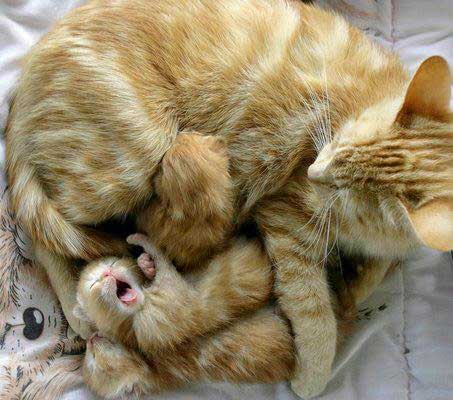DW emailed a nice photograph of what appears to be mother and father cats with their offspring. In groups, sometimes the mothers receive support from other female cats…
There appears to be at least seven kittens, six of which are blue and one tabby. As the adult cat on the left is a tabby I presume that this is a picture of mother and father.
I am not sure which one is the father and which is the mother because it seems that two cats on the left and two or three on the right are or were feeding. Perhaps not. On appearance I would guess that the mother is the mackerel tabby on the left (she looks female).
The interesting point is that mother and father are together raising the kittens at this moment (if I am correct). Kittens spend a lot of time with their mothers during the first months of life. Development of the kittens is all about the mother’s input and the mother-kitten relationship.
The bond between the parents is very weak. After mating it becomes almost non-existent. Linda P Case says, ‘the influence of the sire on kitten behavior is primarily genetic”¹. In other words he does not raise the kids – usually. Perhaps things are a little different in multi-cat households with domestic cats judging by the picture on this page.
Solitary females raise their kittens alone. If the female is living in a group other females may assist. The mother’s role remains significant in the development of her kittens.
After parturation (childbirth) mother stays with her newborn for 24-48 hours. She will lay on her side and by nuzzling and licking her offspring she will encourage them to suckle. After a while she will leave the nest for short sessions. She greets her young on return with a chirping sound.
If a kitten wanders off and cries mother will fetch him back by the scruff of the neck. At about 26-32 days after birth, if the mother is living a semi-domesticated life she will start to hunt for prey to bring it back to feed her young. This is the time of transfer to solid food.
At about five weeks of age the kittens are being taught about hunting and handling of prey as mother brings back live prey, usually mice. The mother may also discourage kittens from suckling at this stage. Weaning has begun (the process of detaching the kitten from feeding on mother’s milk – colostrum).
The weaning process lasts about 4+ weeks. At about a maximum of ten weeks of age kittens are weaned. Cat breeders observe this timetable to make sure their kittens are developed emotionally. Being taken from mother too early can lead to behavior problems such as wool sucking (pica) and cat separation anxiety. Kittens become independent at about 12+ weeks of age.
Kittens learn best by observing mother. Other adult cats who are relations of the kittens can also teach them through example. Kittens deprived of this learning process show ‘impaired learning abilities’¹.
There is possibly a general lack of recognition of the degree to which cats learn through observation. Adults cats will copy humans. The socialisation of kittens to humans and other animals is very important obviously. Kittens learn from mother to be calm around humans if she is calm and friendly towards humans.
Cats are born with a predatory instinct and how-to-hunt skills. They don’t learn these from their mother. They do however learn prey recognition and manipulation and ‘the link between predation and food’ from the early days when mother brings prey back to the den. It would seem that mother refines their innate skills.
In the domestic environment it is possible to create in a kitten a preference for a food type even if the food is unusual. As they observe their mother eating a certain type of food they will copy that. This is kittens imitating their mother. This behavior is strongest at 7-8 weeks of age. These preferences usually carry on after weaning.

Weaning is a major moment in a kitten’s life. The timing is important as if it happens late or early it affects predatory and play behavior later in life. Predatory behavior (‘propensity to kill mice’) is reduced when a kitten is weaned later and vice versa. Kittens who are weaned early play more and develop ‘object play’ earlier. As play and predatory skills are aspects of a cat’s behavior that affects the human-cat relationship, weaning is an important part of breeding purebred cats.
Kittens should remain with their siblings and mother until 8 weeks of age. Weaning should be at a pace dictated by the mother and in the human environment people can start interacting more with the kittens at this time while gentle handling should have taken place from 2 weeks of age to weaning.
Reference: The Cat Its Behavior, Nutrition & Health. ISBN 978-0-8138-0331-9



Yes, Dorothy, I am sure you’re right. Thanks for the comment. It is two nice ladies nursing their kittens together. Really cute and it shows how supportive and sensible mother cats are when raising young.
If you look closely, both cats are nursing their young. I think it is a woman bond. Two fabulous cats, feeding their babies together. Sweet. Nice article Michael, as always